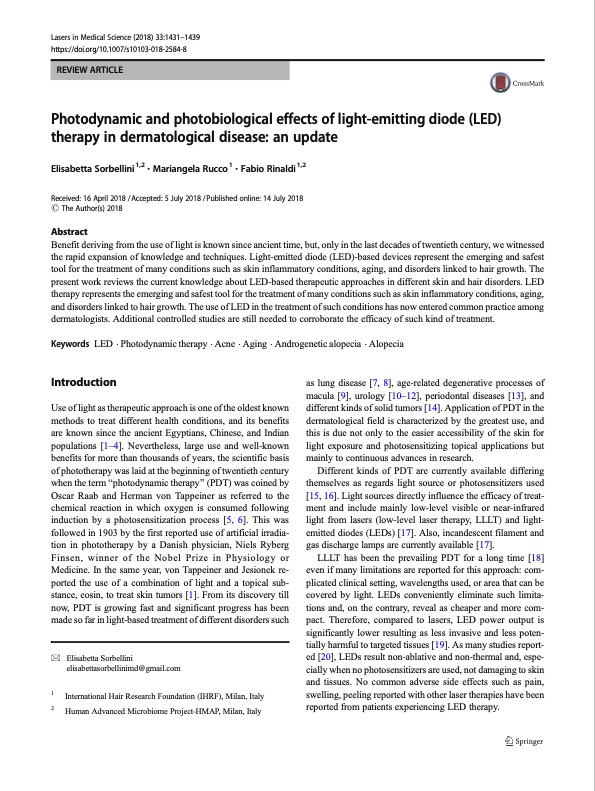
PDF Publication Title:
Text from PDF Page: 001
Lasers in Medical Science (2018) 33:1431–1439 https://doi.org/10.1007/s10103-018-2584-8 REVIEW ARTICLE Photodynamic and photobiological effects of light-emitting diode (LED) therapy in dermatological disease: an update Elisabetta Sorbellini1,2 & Mariangela Rucco1 & Fabio Rinaldi1,2 Received: 16 April 2018 / Accepted: 5 July 2018 / Published online: 14 July 2018 # The Author(s) 2018 Abstract Benefit deriving from the use of light is known since ancient time, but, only in the last decades of twentieth century, we witnessed the rapid expansion of knowledge and techniques. Light-emitted diode (LED)-based devices represent the emerging and safest tool for the treatment of many conditions such as skin inflammatory conditions, aging, and disorders linked to hair growth. The present work reviews the current knowledge about LED-based therapeutic approaches in different skin and hair disorders. LED therapy represents the emerging and safest tool for the treatment of many conditions such as skin inflammatory conditions, aging, and disorders linked to hair growth. The use of LED in the treatment of such conditions has now entered common practice among dermatologists. Additional controlled studies are still needed to corroborate the efficacy of such kind of treatment. Keywords LED . Photodynamic therapy . Acne . Aging . Androgenetic alopecia . Alopecia Introduction Use of light as therapeutic approach is one of the oldest known methods to treat different health conditions, and its benefits are known since the ancient Egyptians, Chinese, and Indian populations [1–4]. Nevertheless, large use and well-known benefits for more than thousands of years, the scientific basis of phototherapy was laid at the beginning of twentieth century when the term Bphotodynamic therapy^ (PDT) was coined by Oscar Raab and Herman von Tappeiner as referred to the chemical reaction in which oxygen is consumed following induction by a photosensitization process [5, 6]. This was followed in 1903 by the first reported use of artificial irradia- tion in phototherapy by a Danish physician, Niels Ryberg Finsen, winner of the Nobel Prize in Physiology or Medicine. In the same year, von Tappeiner and Jesionek re- ported the use of a combination of light and a topical sub- stance, eosin, to treat skin tumors [1]. From its discovery till now, PDT is growing fast and significant progress has been made so far in light-based treatment of different disorders such as lung disease [7, 8], age-related degenerative processes of macula [9], urology [10–12], periodontal diseases [13], and different kinds of solid tumors [14]. Application of PDT in the dermatological field is characterized by the greatest use, and this is due not only to the easier accessibility of the skin for light exposure and photosensitizing topical applications but mainly to continuous advances in research. Different kinds of PDT are currently available differing themselves as regards light source or photosensitizers used [15, 16]. Light sources directly influence the efficacy of treat- ment and include mainly low-level visible or near-infrared light from lasers (low-level laser therapy, LLLT) and light- emitted diodes (LEDs) [17]. Also, incandescent filament and gas discharge lamps are currently available [17]. LLLT has been the prevailing PDT for a long time [18] even if many limitations are reported for this approach: com- plicated clinical setting, wavelengths used, or area that can be covered by light. LEDs conveniently eliminate such limita- tions and, on the contrary, reveal as cheaper and more com- pact. Therefore, compared to lasers, LED power output is significantly lower resulting as less invasive and less poten- tially harmful to targeted tissues [19]. As many studies report- ed [20], LEDs result non-ablative and non-thermal and, espe- cially when no photosensitizers are used, not damaging to skin and tissues. No common adverse side effects such as pain, swelling, peeling reported with other laser therapies have been reported from patients experiencing LED therapy. * 1 2 Elisabetta Sorbellini elisabettasorbellinimd@gmail.com International Hair Research Foundation (IHRF), Milan, Italy Human Advanced Microbiome Project-HMAP, Milan, ItalyPDF Image | Photodynamic and photobiological effects of (LED) therapy

PDF Search Title:
Photodynamic and photobiological effects of (LED) therapyOriginal File Name Searched:
10103_2018_Article_2584.pdfDIY PDF Search: Google It | Yahoo | Bing
Cruise Ship Reviews | Luxury Resort | Jet | Yacht | and Travel Tech More Info
Cruising Review Topics and Articles More Info
Software based on Filemaker for the travel industry More Info
The Burgenstock Resort: Reviews on CruisingReview website... More Info
Resort Reviews: World Class resorts... More Info
The Riffelalp Resort: Reviews on CruisingReview website... More Info
| CONTACT TEL: 608-238-6001 Email: greg@cruisingreview.com | RSS | AMP |